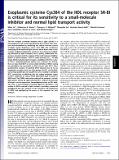Exoplasmic cysteine Cys384 of the HDL receptor SR-BI is critical for its sensitivity to a small-molecule inhibitor and normal lipid transport activity
Author(s)
Saenz-Vash, Veronica; Romer, Katherine A.; Xu, Shangzhe; Yesilaltay, Ayce; Krieger, Monty; Yu, Miao; Nieland, Thomas J; Penman, Marsha L; Carr, Steven A; ... Show more Show less
DownloadKrieger-2011-July-Cys384 of the HDL receptor.pdf (930.4Kb)
PUBLISHER_POLICY
Publisher Policy
Article is made available in accordance with the publisher's policy and may be subject to US copyright law. Please refer to the publisher's site for terms of use.
Terms of use
Metadata
Show full item recordAbstract
The HDL receptor, scavenger receptor, class B, type I (SR-BI), is a homooligomeric cell surface glycoprotein that controls HDL structure and metabolism by mediating the cellular selective uptake of lipids, mainly cholesteryl esters, from HDL. The mechanism underlying SR-BI-mediated lipid transfer, which differs from classic receptor-mediated endocytosis, involves a two-step process (binding followed by lipid transport) that is poorly understood. Our previous structure/activity analysis of the small-molecule inhibitor blocker of lipid transport 1 (BLT-1), which potently (IC[subscript 50] ∼ 50 nM) blocks SR-BI-mediated lipid transport, established that the sulfur in BLT-1’s thiosemicarbazone moiety was essential for activity. Here we show that BLT-1 is an irreversible inhibitor of SR-BI, raising the possibility that cysteine(s) in SR-BI interact with BLT-1. Mass spectrometric analysis of purified SR-BI showed two of its six exoplasmic cysteines have free thiol groups (Cys251 and Cys384). Converting Cys384 (but not Cys251) to serine resulted in complete BLT-1 insensitivity, establishing that the unique molecular target of BLT-1 inhibition of cellular SR-BI dependent lipid transport is SR-BI itself. The C384S substitution reduced the receptor’s intrinsic lipid uptake activity by approximately 60% without dramatically altering its surface expression, homooligomerization, or HDL binding. Thus, a small-molecule screening approach identified a key residue in SR-BI involved in lipid transport, providing a powerful springboard into the analyses of the structure and mechanism of SR-BI, and highlighting the power of this approach for such analyses.
Date issued
2011-07Department
Massachusetts Institute of Technology. Computational and Systems Biology Program; Massachusetts Institute of Technology. Department of Biology; Koch Institute for Integrative Cancer Research at MITJournal
Proceedings of the National Academy of Sciences
Publisher
Proceedings of the National Academy of Sciences (PNAS)
Citation
Yu, M. et al. “Exoplasmic cysteine Cys384 of the HDL receptor SR-BI is critical for its sensitivity to a small-molecule inhibitor and normal lipid transport activity.” Proceedings of the National Academy of Sciences 108.30 (2011): 12243-12248. Web. 1 Feb. 2012.
Version: Final published version
ISSN
0027-8424
1091-6490